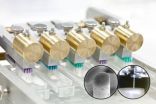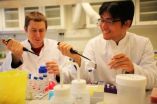(Press-News.org) Many drugs work by "fixing" a particular biological pathway that's gone awry in a disease. But sometimes drugs affect other pathways too, producing undesirable side effects that can be severe enough to outweigh the drug's benefits.
Such is the case for the thiazolidinedione drugs (also known as TZDs), which are used to treat type 2 diabetes. These are highly effective in controlling blood glucose levels and have an added benefit of lowering blood pressure in some patients. However, TZDs cause unrelated but potentially severe side effects in some patients, including heart failure, bone fracture, and to a lesser degree heart attack or bladder cancer depending on the specific TZD. The actual risks vary depending upon a patient's specific circumstances. Nonetheless, because of increased recognition of these unwanted effects, the rate of new TZD prescriptions is on the decline.
"We wanted to discover how TZDs lower blood pressure, so that more specific drugs might be developed that retain the beneficial effect of TZDs but eliminate the detrimental side effects," says Curt Sigmund, Ph.D., professor and head of pharmacology at the UI Carver College of Medicine, and senior author of a new study published Oct. 3 in the journal Cell Metabolism.
The TZD drugs activate a protein called PPAR-gamma. Genetic mutations in this protein disrupt the normal function of blood vessels and cause high blood pressure in people.
Sigmund and his colleagues wanted to home in on the function of PPAR-gamma in blood vessel, so they created a genetically modified mouse where the PPAR-gamma expressed in the blood vessels was mutated. These mice developed high blood pressure.
Using these mice to study how disruption of PPAR-gamma leads to high blood pressure, the researchers uncovered a new biological pathway (called the Cullin-3 pathway) in blood vessels, which may be the key to the blood pressure-lowering effects of TZD drugs.
The study showed that the activity of Cullin-3 in blood vessels is important for maintaining normal blood pressure, and decreased activity of Cullin-3, through disruption of PPAR-gamma, leads to increased blood pressure.
The study results may also help explain another recent finding that mutations in Cullin-3 cause early onset hypertension in people.
Sigmund notes that early research in mice has shown that new molecules, which target PPAR-gamma in new ways, do not have the side effects of TZDs. Whether these new drugs work through the Cullin-3 pathway identified by the UI team will require additional research, he says.
"Our study has added importance because some drugs, which target Cullin-3 and other Cullin proteins, are currently being tested as chemotherapies," adds Sigmund, who also directs the Center for Functional Genomics of Hypertension. "Our findings suggest that blood pressure will have to be monitored in patients undergoing these treatments."
INFORMATION:
In addition to Sigmund, the UI research team included, Christopher Pelham; Pimonrat Ketsawatsomkron; Severine Groh; Justin Grobe; Willem de Lange; Stella-Rita Ibeawuchi; Henry Keen; Eric Weatherford; and Frank Faraci.
The research was funded in part by grants from the National Institutes of Health and the American Heart Association.
END
NEW YORK (Oct. 09, 2012) -- A new study by Weill Cornell Medical College researchers, published in the Journal of General Internal Medicine, provides compelling evidence that electronic health records (EHRs) enhance the quality of patient care in a community-based setting with multiple payers, which is representative of how medicine is generally practiced across the United States.
The use of EHRs is on the rise, in part because the federal government has invested up to $29 billion in incentives promoting the meaningful use of these systems, with the aim of tracking and ...
WINSTON-SALEM, N. C. – Oct. 9, 2012 – The high rate of non-diabetic kidney disease in African-Americans is strongly associated with variations in a particular gene. Yet, not everyone who inherits these variations develops the disease.
Researchers at Wake Forest Baptist Medical Center are working to find out why.
In a study published in the October issue of the journal Kidney International, the research team evaluated children and siblings of African-Americans on dialysis to determine why some develop kidney disease and others don't. These relatives of the dialysis patients ...
Everyone wants to have beautiful teeth. After all, a perfect set of teeth symbolizes health and youthfulness, and can even influence career prospects. If having pristine teeth calls for thorough oral hygiene, then how well or badly does a given toothpaste clean? How effective is it? What should it contain in order not to damage the structure of the teeth? Such questions are primarily of interest to manufacturers of dental hygiene products, and answers are being delivered by researchers from the Fraunhofer Institute for Mechanics of Materials IWM in Halle. Through close ...
The Sun blazes down from a deep blue sky – and rooftop solar cells convert this solar energy into electricity. Not all of it, however: Around a quarter of the Sun's spectrum is made up of infrared radiation which cannot be converted by standard solar cells – so this heat radiation is lost. One way to overcome this is to use black silicon, a material that absorbs nearly all of the sunlight that hits it, including infrared radiation, and converts it into electricity. But how is this material produced? "Black silicon is produced by irradiating standard silicon with femtosecond ...
LOS ANGELES (Oct. 9, 2012) – Approximately 14 percent of individuals suffering from depression and other mental health issues in the United States are minorities in underserved communities, yet very few medications or psychosocial interventions have been developed utilizing the participation of these groups. This year, Bowen Chung, M.D. - principal investigator at The Los Angeles Biomedical Research Institute at Harbor-UCLA Medical Center (LA BioMed) - will change that when two unique studies are initiated: the first study will utilize intervention that focuses on families ...
An SGH study has revealed that considering all osteoporotic patients as having simple osteoporosis and treating all of them alike by putting them on potent long term medication without finding out the cause of their osteoporosis may be ineffective and in most cases downright harmful.
Secondary osteoporosis is a rather common but lesser known type of osteoporosis that affects men and women of any age. It is caused by certain medical conditions that result in bone loss or interfere with development of peak bone mass. Contributors of secondary osteoporosis include conditions ...
Patients who drank coffee, rather than water, after bowel surgery to remove a part of their colon experienced a quicker return to bowel movements and tolerance of solid food.
Those are two of the key findings of a comparative study of 80 patients, carried out at University Hospital Heidelberg, Germany, and published in the surgical journal BJS.
"Post-operative bowel obstruction is a common problem after abdominal surgery and the aim of this study was to test our theory that coffee would help to alleviate this" says lead author Dr Sascha Müller, who is now based at ...
Links to publications:
http://pubs.acs.org/doi/abs/10.1021/nn302633q
http://pubs.acs.org/doi/abs/10.1021/ac201903n
...
ROCHESTER, Minn. -- Mayo Clinic researchers have identified a new therapy for patients with neuromyelitis optica that appears to stop inflammation of the eye nerves and spinal cord. NMO is a debilitating central nervous system disorder that is often misdiagnosed as multiple sclerosis (MS). In the study, patients with severe symptoms of the disease, also known as NMO, were given eculizumab, a drug typically used to treat blood disorders.
While not a cure, the therapy Mayo Clinic researchers used in the study to halt attacks could potentially lead to longer attack-free ...
Scientists at the National Physical Laboratory (NPL) and the University of Leicester have been commissioned by the European Space Agency (ESA) to investigate the feasibility of using dead stars to navigate spacecraft in deep space. The findings of the research will advise ESA strategy and if feasible this technique may in future revolutionise the way spacecraft navigate in the outer Solar System and beyond.
Spacecraft navigation currently relies on radio transmissions between a distant craft and a network of ground-stations on Earth. This means that the craft has to ...

